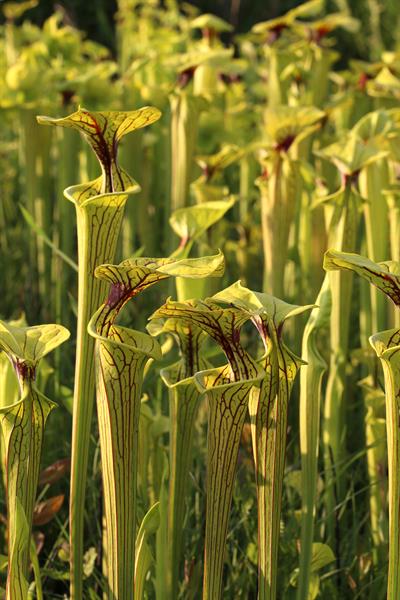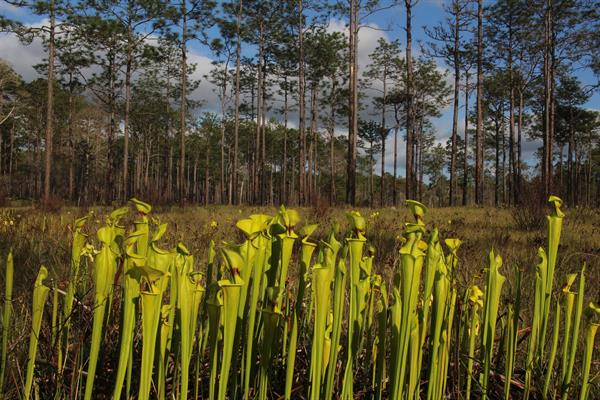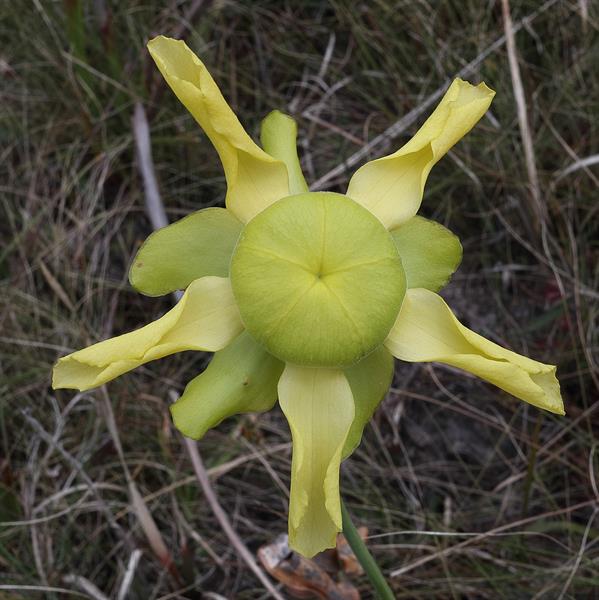
Origin/Endemic status: Endemic
Taxonomy Comments: The many named varieties are best considered forms.
Synonymy: = C, F, Fl5, FNA8, G, GW2, K1, K3, K4, RAB, Va, W, WH3, Bell (1949), McDaniel (1971), Wood (1960); = n/a – Tat; < Sarracenia flava L. – S; > Sarracenia flava L. var. atropurpurea (Bull) C.R.Bell – McPherson & Schnell (2011), Schnell (2002b); > Sarracenia flava L. var. cuprea D.E.Schnell – McPherson & Schnell (2011), Schnell (2002b); > Sarracenia flava L. var. flava – McPherson & Schnell (2011), Schnell (2002b); > Sarracenia flava L. var. maxima Bull ex Mast. – McPherson & Schnell (2011), Schnell (2002b); > Sarracenia flava L. var. ornata Bull ex Mast. – McPherson & Schnell (2011), Schnell (2002b); > Sarracenia flava L. var. rubricorpora D.E.Schnell – McPherson & Schnell (2011), Schnell (2002b); > Sarracenia flava L. var. rugelii (Shuttlew. ex DC.) Mast. – McPherson & Schnell (2011), Schnell (2002b)
Wetland Indicator Status:
- Atlantic and Gulf Coastal Plain: OBL
- Eastern Mountains and Piedmont: OBL
- Northcentral & Northeast: OBL
Heliophily: 9
Hover over a shape, letter, icon, or arrow on the map for definition or see the legend.
 © Will Stuart | Original Image ⭷
© Will Stuart | Original Image ⭷ © Scott Ward | Original Image ⭷
© Scott Ward | Original Image ⭷ © Floyd A. Griffith | Original Image ⭷
© Floyd A. Griffith | Original Image ⭷ © Alan Cressler: Sarracenia flava, Pitcher Plant Savanna, Apalachicola National Forest, Liberty County, Florida 1 by Alan Cressler source | Original Image ⭷
© Alan Cressler: Sarracenia flava, Pitcher Plant Savanna, Apalachicola National Forest, Liberty County, Florida 1 by Alan Cressler source | Original Image ⭷ © Scott Ward | Original Image ⭷
© Scott Ward | Original Image ⭷ © Bruce A. Sorrie | Original Image ⭷
© Bruce A. Sorrie | Original Image ⭷ © Alan Cressler: Sarracenia flava var. ornata, Emanuel County, Georgia 1 by Alan Cressler source | Original Image ⭷
© Alan Cressler: Sarracenia flava var. ornata, Emanuel County, Georgia 1 by Alan Cressler source | Original Image ⭷ © Alan Cressler: Sarracenia flava var. rugelii, Apalachicola National Forest, Franklin County, Florida 1 by Alan Cressler source | Original Image ⭷
© Alan Cressler: Sarracenia flava var. rugelii, Apalachicola National Forest, Franklin County, Florida 1 by Alan Cressler source | Original Image ⭷ © Alan Cressler: Sarracenia flava var. atropurpurea, and Sarracenia flava var. rugelii, Seepage Savanna, Panhandle, Florida 3 by Alan Cressler source | Original Image ⭷
© Alan Cressler: Sarracenia flava var. atropurpurea, and Sarracenia flava var. rugelii, Seepage Savanna, Panhandle, Florida 3 by Alan Cressler source | Original Image ⭷ © Bruce A. Sorrie | Original Image ⭷
© Bruce A. Sorrie | Original Image ⭷ © Alan Cressler: Sarracenia flava var. ornata, Seepage Savanna, Panhandle, Florida 1 by Alan Cressler source | Original Image ⭷
© Alan Cressler: Sarracenia flava var. ornata, Seepage Savanna, Panhandle, Florida 1 by Alan Cressler source | Original Image ⭷ © Alan Cressler: Sarracenia flava var. cuprea, Red Bluff Bay, Francis Marion National Forest, Berkeley County, South Carolina 1 by Alan Cressler source | Original Image ⭷
© Alan Cressler: Sarracenia flava var. cuprea, Red Bluff Bay, Francis Marion National Forest, Berkeley County, South Carolina 1 by Alan Cressler source | Original Image ⭷ © Alan Cressler: Sarracenia flava var. ornata, and Sarracenia flava var. rugelii, Seepage Savanna, Panhandle, Florida 4 by Alan Cressler source | Original Image ⭷
© Alan Cressler: Sarracenia flava var. ornata, and Sarracenia flava var. rugelii, Seepage Savanna, Panhandle, Florida 4 by Alan Cressler source | Original Image ⭷ © Alan Cressler: Sarracenia flava var. ornata, Apalachicola National Forest, Franklin County, Florida 1 by Alan Cressler source | Original Image ⭷
© Alan Cressler: Sarracenia flava var. ornata, Apalachicola National Forest, Franklin County, Florida 1 by Alan Cressler source | Original Image ⭷ © Alan Cressler: Sarracenia flava, Francis Marion National Forest, Berkeley County, South Carolina 2 by Alan Cressler source | Original Image ⭷
© Alan Cressler: Sarracenia flava, Francis Marion National Forest, Berkeley County, South Carolina 2 by Alan Cressler source | Original Image ⭷ © Scott Ward | Original Image ⭷
© Scott Ward | Original Image ⭷ © Scott Ward | Original Image ⭷
© Scott Ward | Original Image ⭷ © Alan Cressler: Sarracenia flava var. maxima, and Sarracenia flava var. rugelii, Seepage Savanna, Panhandle, Florida 1 by Alan Cressler source | Original Image ⭷
© Alan Cressler: Sarracenia flava var. maxima, and Sarracenia flava var. rugelii, Seepage Savanna, Panhandle, Florida 1 by Alan Cressler source | Original Image ⭷ © Scott Ward | Original Image ⭷
© Scott Ward | Original Image ⭷ © Scott Ward | Original Image ⭷
© Scott Ward | Original Image ⭷ © Alan Cressler: Sarracenia flava, Pitcher Plant Savanna, Apalachicola National Forest, Liberty County, Florida 1 by Alan Cressler source | Original Image ⭷
© Alan Cressler: Sarracenia flava, Pitcher Plant Savanna, Apalachicola National Forest, Liberty County, Florida 1 by Alan Cressler source | Original Image ⭷ © Alan Cressler: Sarracenia flava var. rugelii, and Sarracenia flava var. atropurpurea, Seepage Savanna, Panhandle, Florida 1 by Alan Cressler source | Original Image ⭷
© Alan Cressler: Sarracenia flava var. rugelii, and Sarracenia flava var. atropurpurea, Seepage Savanna, Panhandle, Florida 1 by Alan Cressler source | Original Image ⭷ © Johnny Randall | Original Image ⭷
© Johnny Randall | Original Image ⭷ © Alan M. Cressler | Original Image ⭷
© Alan M. Cressler | Original Image ⭷ © Richard & Teresa Ware CC-BY-NC, permission granted to NCBG | Original Image ⭷
© Richard & Teresa Ware CC-BY-NC, permission granted to NCBG | Original Image ⭷ © Bruce A. Sorrie | Original Image ⭷
© Bruce A. Sorrie | Original Image ⭷ © Scott Ward | Original Image ⭷
© Scott Ward | Original Image ⭷ © Alan M. Cressler | Original Image ⭷
© Alan M. Cressler | Original Image ⭷ © Scott Ward | Original Image ⭷
© Scott Ward | Original Image ⭷ © Johnny Randall | Original Image ⭷
© Johnny Randall | Original Image ⭷Feedback
See something wrong or missing on about Sarracenia flava? Let us know here: (Please include your name and email if at all complicated so we can clarify if needed.)
Cite as...